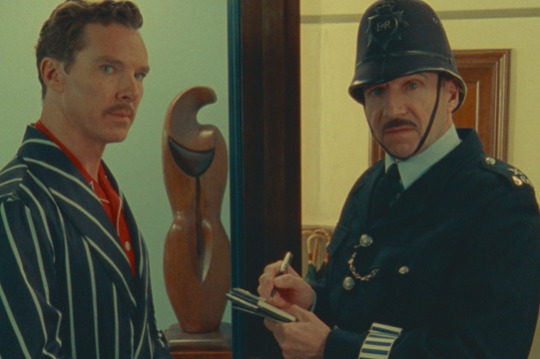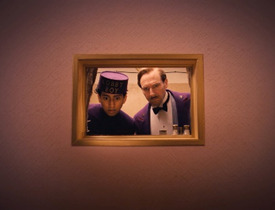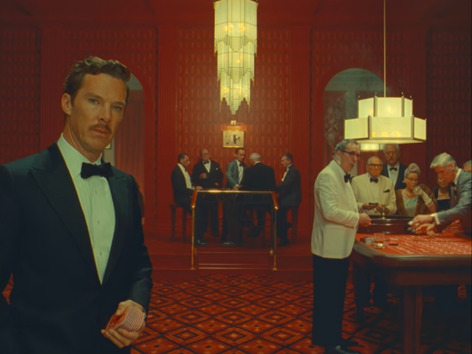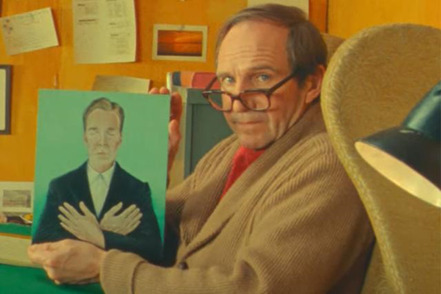Text
Wes Anderson Hasn’t Changed: And How His Unique Style Tells a Story (The Wonderful Story of Henry Sugar and Three More)

Wes Anderson has been one of the most highly renowned filmmakers in the modern independent film movement. You can usually spot an Anderson film from a single, frozen frame. This is because he deliberately and carefully crafts his film worlds in an almost surrealist style. His distinctiveness is achieved through his unique composition, often symmetrical blocking, atmosphere, breaking the fourth wall, and length of shots. Andersons distinct visual style is prevalent in all his films, and one of the most important aspects in his storytelling. The previously mentioned methods that Anderson uses, immediately indicates to the viewer that they are about to be carried into a quirky and immersive world.
Most recently the anthology, The Wonderful Story of Henry Sugar and Three More shares the peculiar styles that Anderson has been developing and perfecting in his previous decades of film creation. Henry Sugar specifically shares all the techniques Anderson’s previous films expanded on to create a visually compelling experience that only Anderson could produce.

Out of the Anderson films of the past, Henry Sugar best resembles his 2014 film, The Grand Budapest Hotel. The similarities are immediately obvious due to the decision for both films to be made in a 4:3 aspect ratio. Additionally, the reasons both films are made in this way are similar. Henry Sugar as well as The Grand Budapest Hotel both take place in the early 20th century, when the 4:3 aspect ratio was the standard. This for one, puts you in the timeframe of the film without outright telling you and gives the film a similar feeling to films of the era. This one choice is also the cause for many unique framings and blockings. The condensed ratio allows for more vertical space to be used in shots. This is one thing that makes this film feel distinctly “Anderson”.
He already is known for his symmetrical dollhouse-like shots which are a staple in the “Anderson” style. “The use of symmetry in Anderson’s films reflects his preference of formalism over realism. Formalism in cinema is a style of filmmaking that reflects the director’s subjective perspective on the world” (Bracken). This application of formalism is the main driver in the dollhouse symmetrical style. There is something so off, yet so visually pleasing in any Anderson scene. If you were to look at the way that any scene is shot, you would notice that every characteristic of the scene is perfectly placed and stationed. This gives that dollhouse feeling.

For example, in Henry Sugar the scene in the hospital (Pictured Above) has many places of symmetry. To either side of the screen, there are the two main doctors. With them in the direct center there is the main subject of the scene. To the back left of the shot, are two more doctors standing side by side nested perfectly in between the left doctor and the man in the middle. To the other side in the background, there are two small windows that serve as the symmetrical balance to the two doctors in the back. This symmetrical balance creates the whimsical, surreal Anderson style which builds the feeling of his films. “Anderson intentionally creates scenes that feel almost real, but something always seems unnatural, with the characters existing in their own little Twilight Zone” (Rawlings).

As for how the 4:3 aspect ratio creates the distinct Anderson style, the casino scene is a great example of how vertical space is used to make up for the limitations of horizontal space. Since things need to be more squished in the 4:3 ratio, Anderson used perspective and vertical space to create a visually interesting scene. From the top of the ceiling in the background there is a large chandelier that centers the table in the back. To the right side, there is another casino game being played which is also being centered by its own light. Then on the left we have the character Henry Sugar balancing out the other parts of the shot. The way that things are placed allows for a lot of wall space being shown for off in the background, making the room feeling large. Then with Henry so close to the camera balancing everything out he becomes the focus of the shot.
Anderson also likes to use a lot of long takes in his films, especially in Henry Sugar. Which adds to the whimsical nature of his films. Henry Sugar uses many long takes throughout its almost 40-minute runtime. A long take is a scene that is or is meant to appear like it was taken in one shot. The way that Anderson uses long takes in Henry Sugar is unique. The short film has an almost play-like feeling, which is created by the way that settings are changed within the long takes. The backgrounds move and change as they would when you are watching a live play. The movement gives the film the feeling that the world and set itself is living and breathing.
youtube
These long takes and moving parts are engaging and visually interesting. The way that the sets dynamically move to create the next background, and how they come together perfectly is essential in creating the Anderson whimsy. In the casino scene previously mentioned, there is a lot of set movement that is a great example of this. At the start of the scene, Henry Sugar walks into the casinos lobby. The walls behind are moved to reveal where the cashier would be, then the wall once again moves to open into the large casino floor (the person who plays the cashier also swiftly switches positions to move the wall, which is a great showing of how intricate the film can be). The rest of the scene takes place within the casino floor, then once everything concludes henry Sugar back tracks in the same way back to the lobby. This scene is an astonishing example of how not just the characters, but the worlds in Andersons films have their own distinct feeling.

Something that Wes Anderson isn’t afraid of doing, is breaking the fourth wall at strategic moments. In many scenes, characters can be seen looking directly into the camera, and this happens essentially throughout the entire film. The film takes the form of many monologues that are geared toward the viewer. This engages the viewer in a deeper way and allows for more of the whimsical Anderson nature to shine forth. It seems like characters are aware that there is a viewer, and they are catering to them directly. In this film it is done through the writing, and characters looking directly into the camera.
Many times, when characters are looking into the camera it is almost like they are saying, “we know you know this is absurd”. Taking another look at the hospital scene, the two doctors break the fourth wall and look at the camera after the old man tells them he can see without his eyes. This is a ridiculous claim to make, and the doctors break the fourth wall to tell you they know they are aware of that without using dialogue. The characters looking directly into the camera in this scene, and addressing the viewer adds to the Anderson charm. Otherwise, the characters are always addressing the viewer in some way. The way the characters speak is as if they are telling a story to someone, and the way that the film visually identifies itself is complimentary of that.
Since the late 1990’s Wes Anderson has been developing a unique, interesting, and engaging visual and storytelling style that is uniquely his own. The Wonderful Story of Henry Sugar and Three More uses all of the tools Anderson has gained throughout his filmmaking tenure to make a unique addition to his filmography. Through the set design, shot symmetry, long takes, breaking the fourth wall, and the quirky atmosphere that is created from all these implemented traits creates a film that is engaging, interesting, and assuredly “Anderson”.
Works cited:
Bracken, Madyson. “Why Wes Anderson Is Obsessed with Symmetry.” MovieWeb, 29 June 2023, movieweb.com/wes-anderson-movies-symmetry/#:~:text=The%20use%20of%20symmetry%20in,world%20in%20an%20objective%20sense.
Rawlings, Will. “The Beauty of...Wes Anderson.” Duke Independent Film Festival, Duke Independent Film Festival, 10 Feb. 2022, sites.duke.edu/dukeiff/2022/02/10/the-beauty-of-wes-anderson/.
4 notes
·
View notes